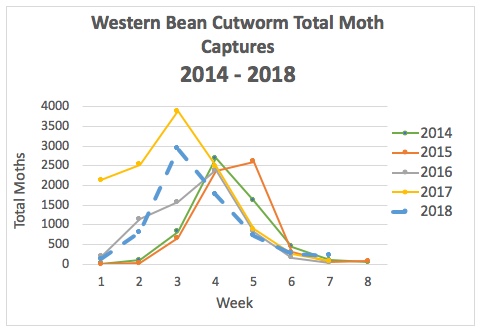For reasons that are unclear – but likely related to two seasons of increased monitoring and spraying – the western bean cutworm damage is far lower than the past two seasons. Very few reports of ear infestations have been received from northern Indiana counties, where risks are greatest. In looking at a comparison of the 5-year moth captures (see graph below), there were plenty of moths flying. However, this only tells a portion of the story. “Week 3,” just after Independence Day, was when most moths were present, mating and laying eggs. However, because of this year’s rapid pace of corn growth and development, over 50% of the corn had already been pollinated. Western bean cutworm’s egg laying preference is pre-tassel corn, meaning that their flight lined up poorly this year. Perhaps the lower damage this year can simply be attributed to their poor timing…likely there is much more we don’t understand, e.g., abnormally wet soil conditions in that region this spring. Remember also that they have hosts other than corn, and may move to those when corn is not at the right stage for oviposition.
Tracking the western bean cutworm moth flight wouldn’t be possible without the many pheromone trap cooperators in our network. To those volunteers, we are all in debt! Please thank any of those cooperators that you may know for their efforts. Hug them, if possible and appropriate.



